Peer review and publication metrics | Citation metrics | Citation distributions | Usage data | Author geography | Where GSL publications are indexed
The Geological Society of London is a signatory of the San Francisco Declaration on Research Assessment (DORA) which aims to eliminate the use of journal-based metrics, such as Journal Impact Factors, as a surrogate measure for the quality of an individual research article or an individual scientist’s contributions (San Francisco Declaration on Research Assessment).
This page presents the publication metrics for all of the journals published by the Geological Society of London so that citation metrics and peer review indicators can be viewed in context. Article level metrics and usage data are also available on individual articles and we recommend that these are used to assess a contribution rather than the journal it is published in.
This page presents data from 2022 for the journals:
Peer review and publication metrics
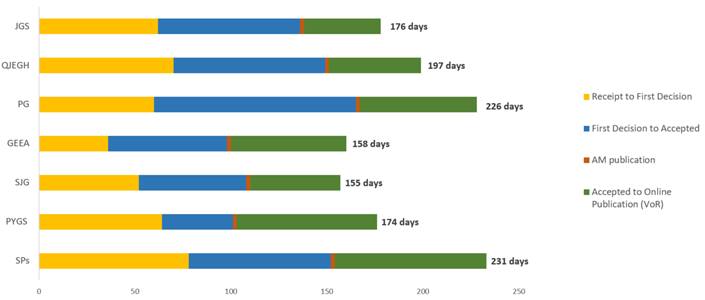
Submission to initial decision: the median number of days when a complete submission is received to it receiving a first decision after peer review. This does not include desk-rejects where articles not in a journal’s scope are rejected quickly prior to peer review by an editor.
Initial decision to accepted: the median number of days from initial positive decision to final decision. This includes the time taken by authors to make any required edits or revisions.
Accepted manuscript publication: the median number of days taken to the post the authors’ accepted version of the manuscript (post-peer review but prior to typesetting, copyediting etc.) online with a DOI.
Online publication: the median number of days from acceptance to online publication of the version of record.
Citation metrics
| Impact metrics 2022 |
JGS |
QJEGH |
PG |
GEEA |
SJG |
PYGS |
| Journal Impact Factor |
2.7 |
1.4 |
1.7 |
2.4 |
0.7 |
1 |
| 5-year Impact Factor |
3.1 |
1.4 |
2.2 |
1.9 |
0.8 |
0.8 |
| SNIP |
0.925 |
0.695 |
1.019 |
0.575 |
0.198 |
0.987 |
| SJR |
1.122 |
0.355 |
0.868 |
0.402 |
0.209 |
0.67 |
Journal Impact Factor: Journal Impact Factor is published annually by Clarivate Analytics and uses data from the Science Citation Index. It is calculated through dividing the number of citations in the current year to those citable items published in that journal during the preceding two years.
5-year Impact Factor: 5-year Impact Factor is the same as the Journal Impact Factor but uses 5 years’ worth of cited articles instead of 2. This is useful in disciplines where citation rates are slower.
SNIP: Source Normalised Impact per Paper (SNIP) uses the Scopus database and aims to measure the journal’s contextual citation impact. To do this it divides the journal’s citation count per paper by the citation potential in its subject field.
SJR: SCImago Journal Rank uses the Scopus database and aims to measure the average scientific prestige of an article in a journal. It uses an algorithm to assign relative scores to all sources in a citation network based on subject field, quality and reputation of the source journal, inspired by the Google PageRank, so that not all citations are equal.
Citation distributions
| JGS |
QJEGH |
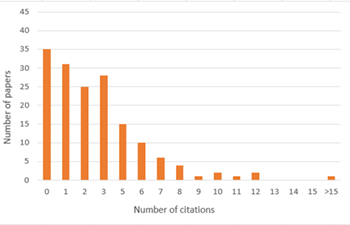 |
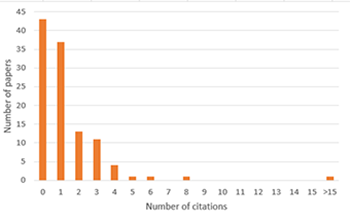
|
| |
|
| PG |
GEEA |
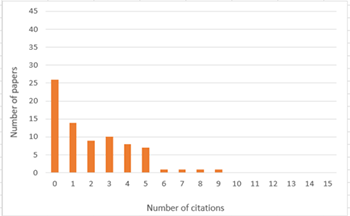 |
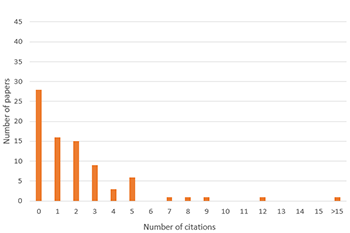
|
| |
|
| SJG |
PYGS |
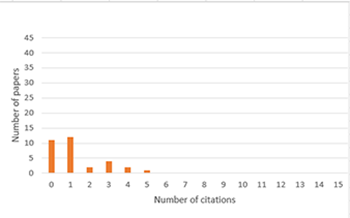 |
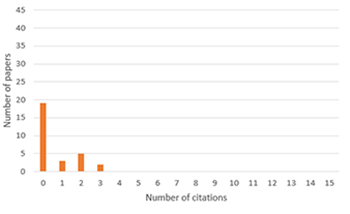 |
The flaws in the Journal Impact Factor are well-documented. Using the same two-year window as the Journal Impact Factor, a citation distribution histogram reveals the patterns beneath that metric.
See this preprint for methodology. “A simple proposal for the publication of journal citation distributions” by Vincent Lariviere, Veronique Kiermer, Catriona J MacCallum, Marcia McNutt, Mark Patterson, Bernd Pulverer, Sowmya Swaminathan, Stuart Taylor and Stephen Curry. BioRxiv. Posted July 5, 2016. https://dx.doi.org/10.1101/062109.
Usage data
| Journal |
Total full-text usage in 2022 |
| JGS |
214788 |
| QJEGH |
105863 |
| PG |
57122 |
| GEEA |
28582 |
| SJG |
26346 |
| PYGS |
38420 |
Usage data: relates to both the full-text html of an article and PDF downloads on the Lyell Collection. Abstract-only views are not included nor is usage from GeoScienceWorld (or Earthdoc, where PG is also hosted).
Author geography
| JGS |
QJEGH |
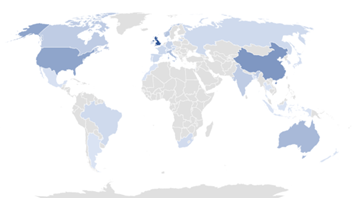
|
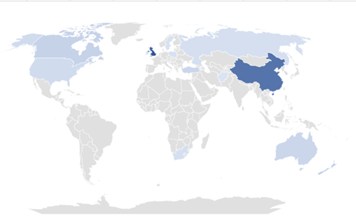
|
| |
|
| PG |
GEEA |
 |
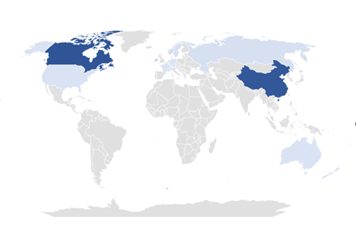
|
| |
|
| SJG |
PYGS |
 |
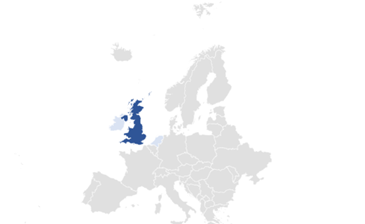 |
Author geography: geographical location of all published authors in a given year.
Where GSL publications are indexed
Scopus
All the journals published by the Society and all the book series in the Lyell Collection are included in Elsevier’s Scopus. Metrics based on Scopus data are available free of charge through the SCImago website. We have included SJR on our website, but other metrics are available on the SCImago site. Note that these metrics are not very helpful for irregularly-published book series like Memoirs and EGSPs.
Clarivate’s Web of Science/Web of Knowledge
All the journals published by the Geological Society (including those published on behalf of other societies) are included in the Web of Science ‘Science Citation Index’.
Most of the books published by the Geological Society, including Special Publications, Memoirs, EGSPs and the TMS and IAVCEI series, are included in the Web of Science ‘Book Citation Index’ or the ‘Conference Proceedings Citation Index’. Both of these indexes allow authors to obtain citation counts for their articles and they accrue towards their h-index.
Authors should note that WoS data pertaining to their articles are only available via an institutional subscription. WoS is a modular product and their institution needs to have subscribed to the relevant components.
GoogleScholar
It is very easy to find Lyell Collection articles in GoogleScholar and citation counts are shown. Authors can register, which allows them to see their h-index and other information. Search for ‘Albert Einstein’ to see an example of an author profile. Using the ‘Metrics’ link you can find journal and book series h5-indexes, the most highly cited articles in that journal and which articles have cited them.
GeoRef
The Society’s publications are indexed by AGI for GeoRef. Special Publications and the Society’s four journals are all priority titles.